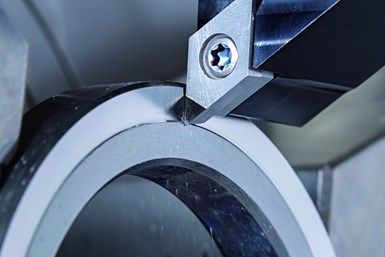Tungaloy-NTK PCD Grade Offers Optimal Dimensional Accuracy
The DX200 is an effective tool for machining application-specific components that demand high levels of material purity, such as metal medical implants and sputtering targets for semiconductor applications.
Tungaloy-NTK America Inc. has unveiled its latest development of a polycrystalline diamond (PCD) grade that is designed to provide exceptional wear resistance in hard, non-ferrous metals. DX200 is made of 100% pure diamond using no binder to make the bond between the diamond grains.
Boasting the highest hardness of all Tungaloy’s PCD-grade lines, DX200 is best suited for finish machining of carbide and hard, brittle materials, primarily tungsten carbide, cemented carbide and metal matrix composites (MMCs). In addition, the PCD cutting edge features an excellent edge-line security and sharpness, permitting the insert to achieve optimized dimensional accuracy over extended periods of time.
Unlike traditional PCD grades that use a metallic binder such as cobalt to make the grains bond to one another, DX200 directly binds the diamond particles without using binder materials. This enables the grade to have an extremely pure cutting edge, making it an effective tool for machining application-specific components that demand high levels of material purity, such as metal medical implants and sputtering targets for semiconductor applications.
DX200 grade is available in seven inserts of CCGW and DCGW shapes with 0.2- and 0.4-mm nose radii.
Related Content
-
Boring Head Enables Sculpture Hardware to Be Machined on a Lathe
When small job shop Ansonia Manufacturing took on a tricky hardware component job for a “live” glass art sculpture, it realized a boring head would be needed to machine the part complete on its live-tool lathe.
-
Tool Path Improves Chip Management for Swiss-Type Lathes
This simple change to a Swiss-type turning machine’s tool path can dramatically improve its ability to manage chips.
-
Making Micro Threads
Production of micro threads can be challenging, but using the most suitable tools for a given application can simplify the task.






.png;maxWidth=300;quality=90)







